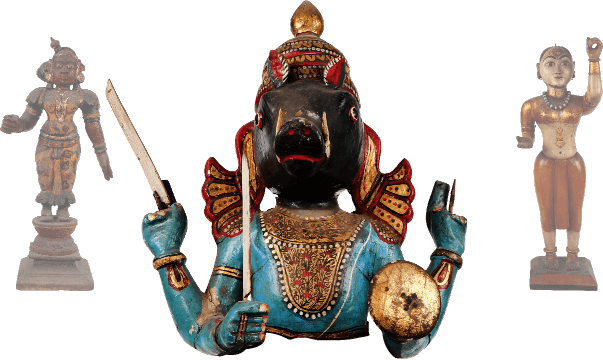Title : Figure of an Animal
Accession No : VC/88/34(2)
"The figure showcases a terracotta made animal which resembles a Cow. The cow is standing on its legs, which are long and cylindrical in shape. The neck is arched and the face is pointed towards the front. The face prominent eyes and there are small linear patterns in the centre. The back has a serated motif towards the hinge side and the lower part of body has clearly visible genitals. The ears are flared and upraised. There are two circular cavities on its body on either sides. The natural colour of terracotta is retained on the object. "
Gallery


Provenance
- StateMadhya Pradesh
Condition
- ConditionAverage
- Action NoteCR; Accumulation of Dust; Faded Surface; Dirt Accretions
Dimensions
- Measurement (CMS)31 x 27 x 12
- Weight (GRMS)0.00
Significance
- Socio economicTerracotta is clay-based ceramic pottery known for its expression of the Human mind for ages. According to Hindu beliefs, this ancient form is considered auspicious for incorporating all the five classical elements of nature, namely, air, water, earth, fire, and space. Tracing back to its history, Terracotta models were found in abundance from the sites of Indus Valley Civilization like Birhana, Mehrgarh, Harappa, Mohenjodaro, etc. which dates backs to around 7000 BC. Slowly it was welcomed by Indian households in the form of kitchenware and other utility products, and gradually growing into homemade art and pottery. States like Gujarat, Rajasthan, and Madhya Pradesh still cherish their cultural heritage that propagates around Terracotta art, with distinctive crafts like hand-made jars, embroidered rooftops, and lanterns.
- ArtisticThe name Terracotta is derived from the Latin words ‘terra’ meaning ‘bake’ and ‘cotta’ stands for ‘earth’, which together translates to baked earth. These potteries are glazed or unglazed versions made from clay that has been dried and fired at 1000°C, resulting in distinct colors of orange, red, brown, yellow or gray. Once burned, it is cooled and brought to normal temperature by covering it in the sand. Therefore its color depends on both the type of clay used as well as the firing process.
Description
- Description"The figure showcases a terracotta made animal which resembles a Cow. The cow is standing on its legs, which are long and cylindrical in shape. The neck is arched and the face is pointed towards the front. The face prominent eyes and there are small linear patterns in the centre. The back has a serated motif towards the hinge side and the lower part of body has clearly visible genitals. The ears are flared and upraised. There are two circular cavities on its body on either sides. The natural colour of terracotta is retained on the object. "
- Inscription/Markings No
- Reference"Ranjan, Aditi. Handmade in India: Crafts of India. Edited by Aditi Ranjan & M. P. Ranjan. Ahmedabad: Council of Handicraft Development Corporations, 2007. Imoba, Laishram, Thiyam Rabikanta, and Chirom Rajketan. Pottery in Manipur. Imphal: Mutua Museum, 1999. Perryman, Jane. Traditional Pottery of India. Bedford Row, London: A and C Black, 2000."
- KeywordPottery, Animal, Cow, Toy, Terracotta, Decorative


/VC88342C.jpg)
/VC88342D.jpg)
/VC88342E.jpg)
/VC88342F.jpg)